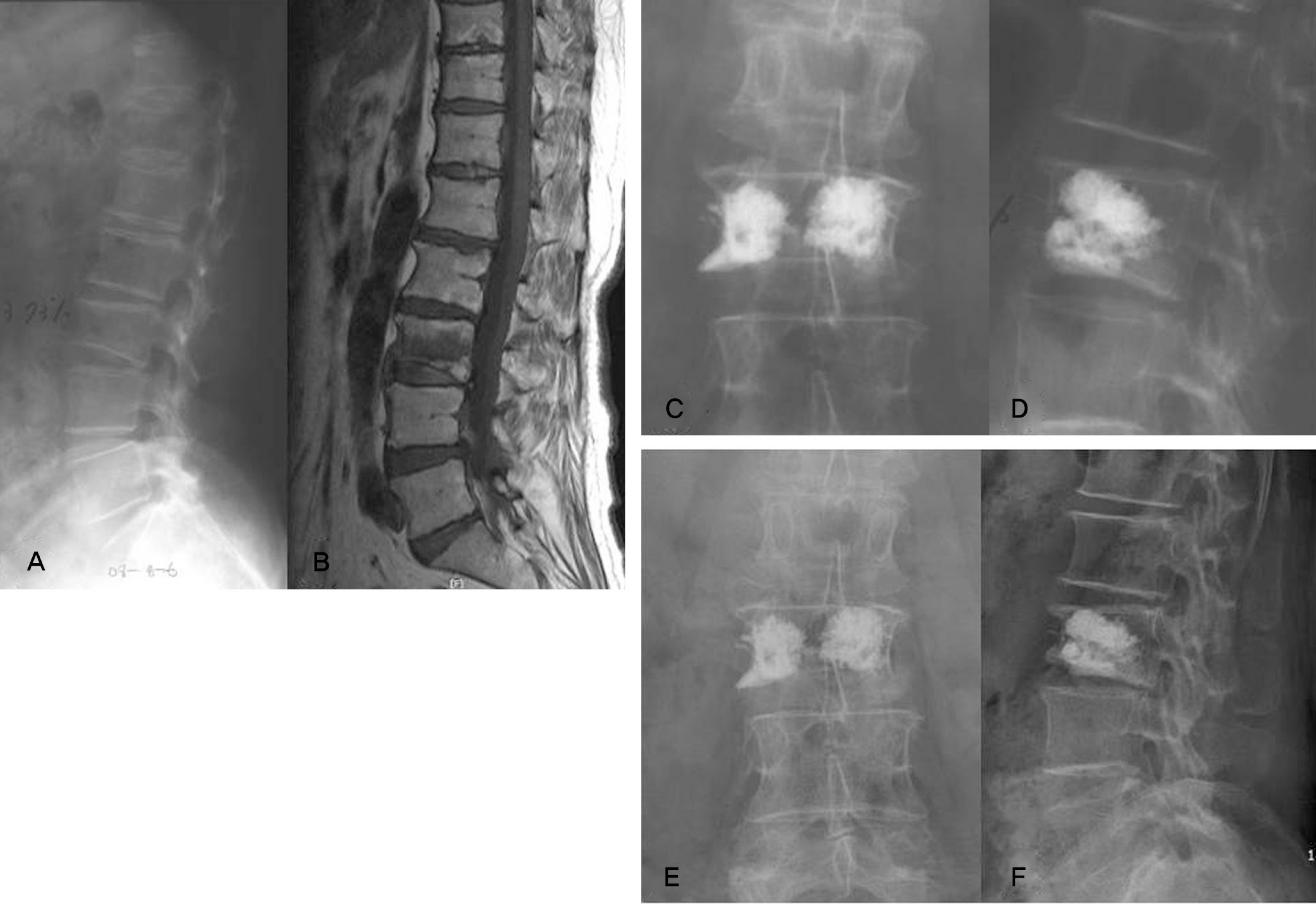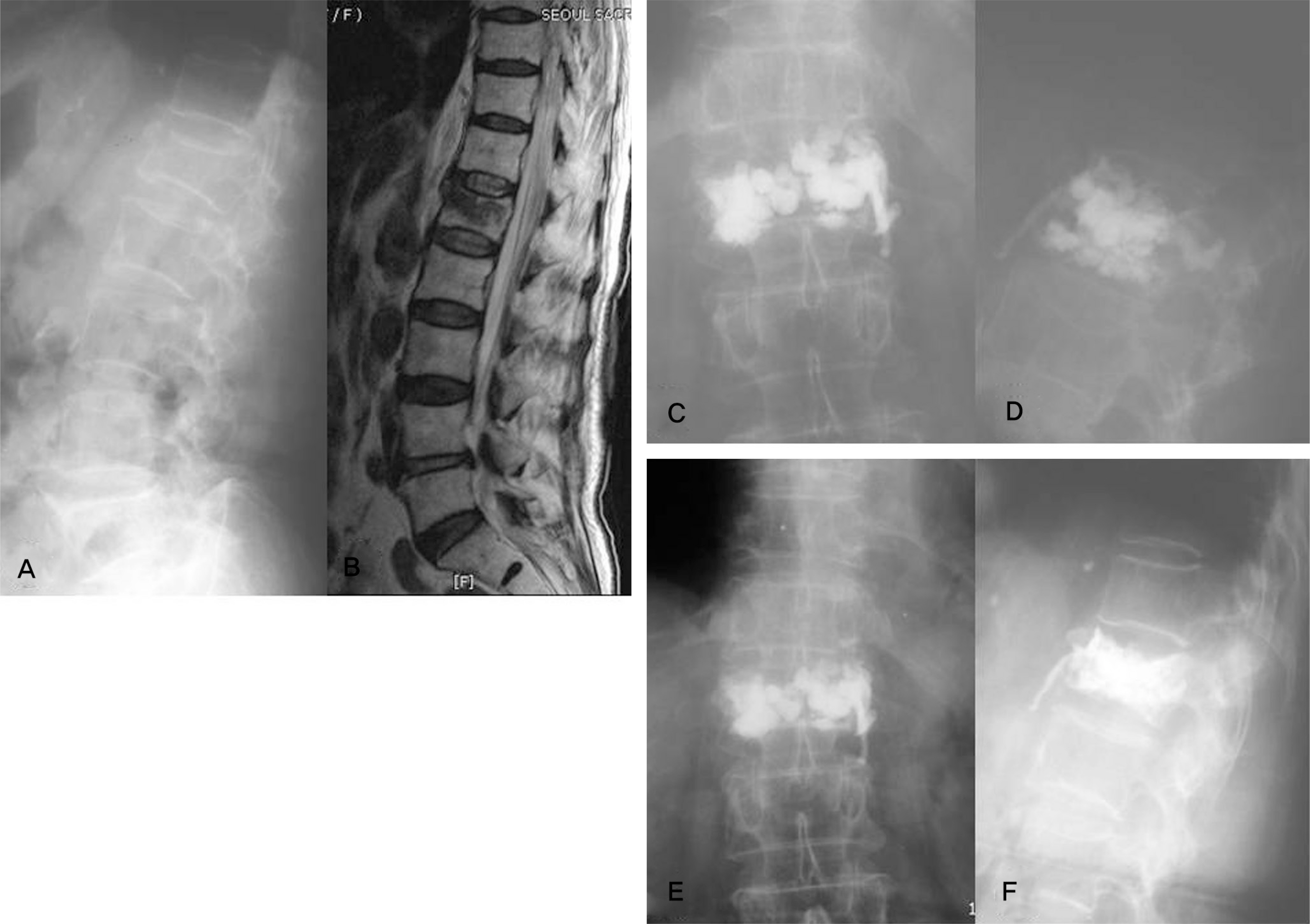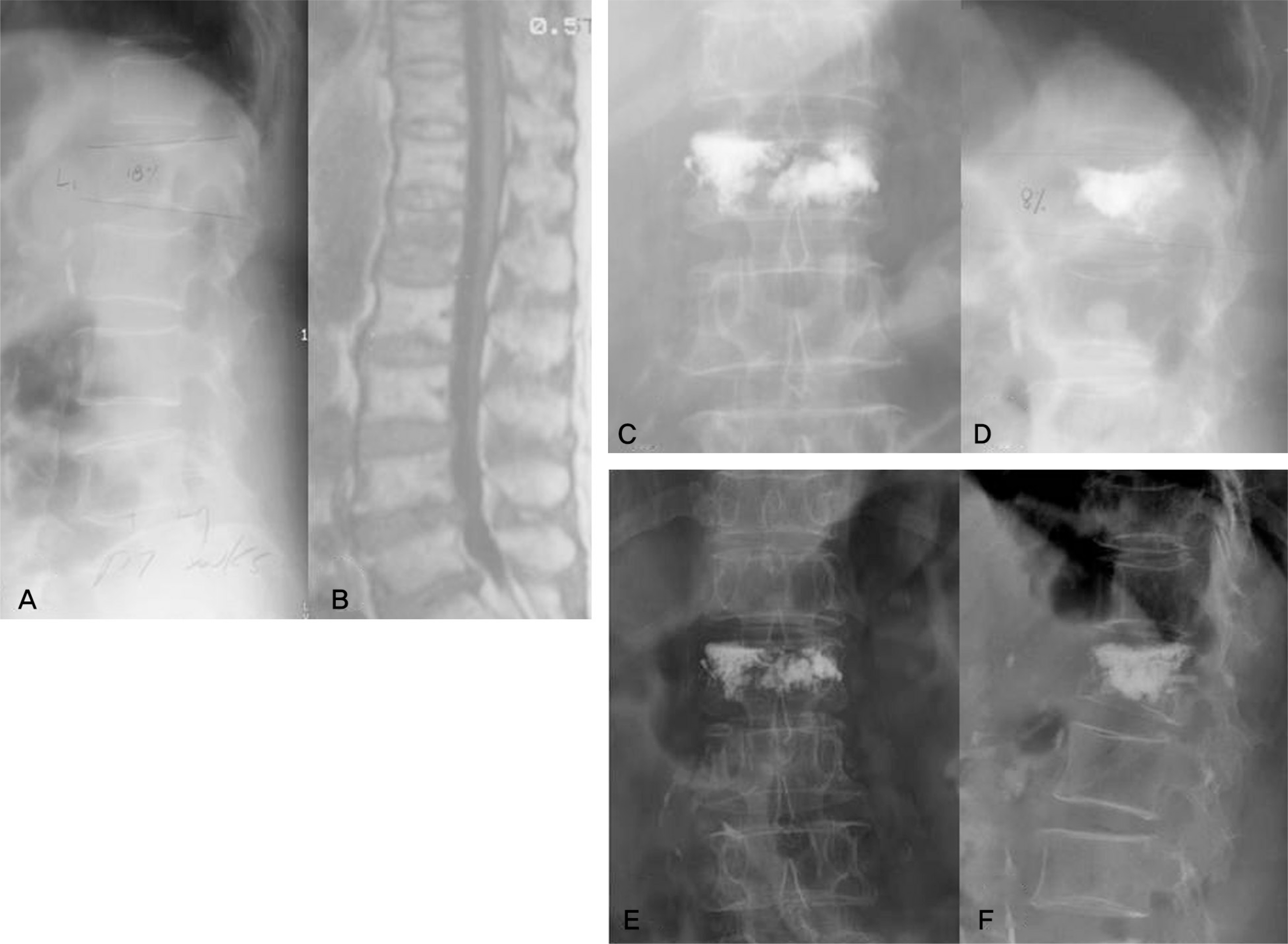J Korean Soc Spine Surg.
2010 Sep;17(3):127-138. 10.4184/jkss.2010.17.3.127.
Lower-Pressure Percutaneous Vertebroplasty Using Larger-Diameter Bone-Cement Fillers
- Affiliations
-
- 1Department of Orthopedic Surgery, Seoul Sacred Heart General Hospital, Seoul, Korea. niceosu@freechal.com
- KMID: 1459278
- DOI: http://doi.org/10.4184/jkss.2010.17.3.127
Abstract
- STUDY DESIGN: This is a retrospective, case-controlled study.
OBJECTIVE
We wanted to evaluate the efficacy of lower-pressure percutaneous vertebroplasty (LP-PVP) using larger-diameter cement fillers for treating osteoporotic vertebral compression fracture (VCF). SUMMARY OF THE LITERATURE REVIEW: Despite the popularity of conventional PVP(C-PVP), critical complications associated with cement leakage have been widely reported due to the inadequate viscosity of flabby cement.
MATERIALS AND METHODS
With excluding Kummell's disease, 23 VCF's were treated with LP-PVP using 2.8mm-diameter cement fillers, 51 VCF's were treated with kyphoplasty(KP) using the same size of cement fillers and 19 VCF's were treated with C-PVP using 1.4mm-diameter biopsy needles. The clinical and radiographic results along with the complications were investigated for more than one year.
RESULTS
The visual analogue scale (VAS) was improved in all the groups. The infused cement volume was 5.9+/-1.6ml for the LP-PVP, 5.9+/-1.9ml for the KP and 3.5+/-1.0ml for the C-PVP (p=0.000). The collapsed vertebral height was restored by 10.8+/-10.3%, 13.0+/-12.7% and 4.7+/-7.6%, respectively, in each group (p=0.000) with a reduction loss of 2.1+/-1.8%, 1.1+/-1.4% and 5.9+/-4.2%. respectively, in each group (p=0.000) at follow-up. These was a reduction of the vertebral kyphotic angle by 3.0+/-4.0degrees, 3.7+/-4.4degrees and 4.2+/-4.4degrees, respectively, in each group (p=0.528) with reduction loss of 1.0+/-0.9degrees, 0.1+/-1.7degrees and 3.5+/-2.8degrees, respectively, in each group (p=0.000). There was a reduction of the regional Cobb's angle by 4.3+/-2.6degrees, 3.1+/-4.7degrees and 2.9+/-3.8degrees, respectively, in each group (p=0.184) with a reduction loss of 3.6+/-4.5degrees, 0.1+/-1.5degrees and 1.0+/-4.1degrees, respectively, in each group (p=0.000). Extravasation of cement was noticed in 6 cases (26.1%) of LP-PVP, in 14 cases (27.5%) of KP and 4 cases (26.1%) of C-PVP (p=0.689). No cases of additional VCF happened for the LP-PVP, eight cases of additional VCF happened (15.7%) for the KP and one case of additional VCF happened (5.3%) for the C-PVP (p=0.030).
CONCLUSION
The LP-PVP showed clinically and radiologically results that were similar to those of KP with a higher amount of infused cement volume compared to that of C-PVP. LP-PVP is thought to be effective for the clinical and radiolographic aspects and to have fewer complications for the treatment of osteoporotic VCF.
MeSH Terms
Figure
Reference
-
1.Kado DM., Browner WS., Palermo L., Nevitt MC., Genant HK., Cummings SR. Vertebral fractures and mortality in older women: a prospective study. Arch Intern Med. 1999. 159:1215–20.2.Cho YS., Cho SD., Kim BS., Park TW., Lew SU., Cho SH. Percutaneous vertebroplasty for osteoporotic compression fractures. J Korean Orthop Assoc. 2002. 37:13–8.
Article3.Na HY., Cho HW., Kim SK., Lee SY. Comparison of outcome between percutaneous vertebroplasty and kyphoplasty for osteoporotic painful vertebral compression fracture - a preliminary report -. J Korean Soc Spine Surg. 2003. 10:127–36.
Article4.Chen JK., Lee HM., Shih JT., Hung ST. Combined extraforaminal and intradiscal cement leakage following percutaneous vertebroplasty. Spine. 2007. 32:358–62.
Article5.Lim SH., Kim H., Kim HK., Baek MJ. Multiple cardiac perforations and pulmonary embolism caused by cement leakage after percutaneous vertebroplasty. Eur J Cardiothorac Surg. 2008. 33:510–2.
Article6.Pradhan BB., Bae HW., Kropf MA., Patel VV., Delamarter RB. Kyphoplasty reduction of osteoporotic vertebral compression fractures: correction of local kyphosis versus overall sagittal alignment. Spine. 2006. 31:435–41.
Article7.Voggenreiter G. Balloon kyphoplasty is effective in deformity correction of osteoporotic vertebral compression fractures. Spine. 2005. 30:2806–12.
Article8.Taylor RS., Taylor RJ., Fritzell P. Balloon kyphoplasty and vertebroplasty for vertebral compression fractures: a comparative systematic review of efficacy and safety. Spine. 2006. 31:2747–55.9.Nussbaum DA., Gailloud P., Murphy K. A review of complications associated with vertebroplasty and kyphoplasty as reported to the Food and Drug Administration medical device related web site. J Vasc Interv Radiol. 2004. 15:1185–92.
Article10.Heini PF., Orler R. Kyphoplasty for treatment of osteoporotic vertebral fractures. Eur Spine J. 2004. 13:184–92.11.Jun DS., Shin WJ., Koh YH., Moon SH. MR predictors of bone cement leakage in percutaneous vertebroplasty and kyphoplasty for painful osteoporotic vertebral compression fracture. J Korean Soc Spine Surg. 2006. 13:184–90.
Article12.Ledlie JT., Renfro MB. Kyphoplasty treatment of vertebral fractures: 2-year outcomes show sustained benefits. Spine. 2006. 31:57–64.
Article13.Cotten A., Dewatre F., Cortet B, et al. Percutaneous vertebroplasty for osteolytic metastases and myeloma: effects of the percentage of lesion filling and the leakage of methyl methacrylate at clinical follow-up. Radiology. 1996. 200:525–30.
Article14.Mirovsky Y., Anekstein Y., Shalmon E., Blankstein A., Peer A. Intradiscal cement leak following percutaneous vertebroplasty. Spine. 2006. 31:1120–4.
Article15.Lin EP., Ekholm S., Hiwatashi A., Westesson PL. Vertebroplasty: cement leakage into the disc increases the risk of new fracture of adjacent vertebral body. Am J Neuroradiol. 2004. 25:175–80.16.Luginbü hl M. Percutaneous vertebroplasty, kyphoplasty and lordoplasty: implications for the anesthesiologist. Curr Opin Anaesthesiol. 2008. 21:504–13.17.Loeffel M., Ferguson SJ., Nolte LP., Kowal JH. Vertebroplasty: experimental characterization of polymethylmethacrylate bone cement spreading as a function of viscosity, bone porosity, and flow rate. Spine. 2008. 20:1352–9.18.Bohner M., Gasser B., Baroud G., Heini P. Theoretical and experimental model to describe the injection of a polymethylmethacrylate cement into a porous structure. Biomaterials. 2003. 24:2721–30.
Article19.Baroud G., Crookshank M., Bohner M. High-viscosity cement significantly enhances uniformity of cement filling in vertebroplasty: an experimental model and study on cement leakage. Spine. 2006. 31:2562–8.
Article20.Kim MJ., Lindsey DP., Hannibal M., Alamin TF. Vertebroplasty versus kyphoplasty: biomechanical behavior under repetitive loading conditions. Spine. 2006. 31:2079–84.
Article21.Shin DA., Kim KN., Shin HC., Kim SH., Yoon DH. Progressive collapse of PMMA-augmented vertebra: a report of three cases. Zentralbl Neurochir. 2008. 69:43–6.
Article22.Watanabe K., Lenke LG., Bridwell KH., Kim YJ., Koester L., Hensley M. Proximal junctional vertebral fracture in adults after spinal deformity surgery using pedicle screw constructs: analysis of morphological features. Spine. 2010. 35:138–45.23.Ahn DK., Choi DJ., Lee S., Kim KS., Kim TW., Chun TW. The efficacy of kyphoplasty on osteoporotic vertebral compression fracture: a 1-year follow-up study. J Korean Soc Spine Surg. 2009. 16:79–88.
- Full Text Links
- Actions
-
Cited
- CITED
-
- Close
- Share
- Similar articles
-
- Lumbar Root Injury by the Leakage of Bone Cement after the Percutaneous Vertebroplasty: A case report
- Fatal Hemothorax Following Percutaneous Vertebroplasty: A Case Report
- Technical Modification of Vertebroplasty
- Intracardiac Foreign Body (Bone Cement) after Percutaneous Vertebroplasty
- Asymptomatic Bone Cement Pulmonary Embolism after Percutaneous Vertebroplasty: A Case Report




